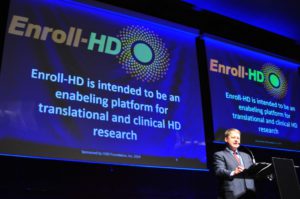Platform
Enroll-HD as a platform
 In some ways, Enroll-HD is not so unusual. Like other observational or “natural history” studies, it monitors symptoms and underlying changes caused by disease over time. Information is collected every year, from the same people, for a long time. The information can be a major help in the search for treatments because it provides reliable measurements of what is happening inside the brain and rest of the body with HD. And it’s essential for testing new drugs that are intended to prevent or slow the progression disease; the only way to tell if a treatment is really working is to have an accurate record of what usually happens as the disease progresses. Then in clinical trials volunteers can be given the drug and the results compared with the predicted course of disease. For all these reasons, Enroll-HD is a lot like other observational studies of diseases like Parkinson’s and Alzheimer’s.
In some ways, Enroll-HD is not so unusual. Like other observational or “natural history” studies, it monitors symptoms and underlying changes caused by disease over time. Information is collected every year, from the same people, for a long time. The information can be a major help in the search for treatments because it provides reliable measurements of what is happening inside the brain and rest of the body with HD. And it’s essential for testing new drugs that are intended to prevent or slow the progression disease; the only way to tell if a treatment is really working is to have an accurate record of what usually happens as the disease progresses. Then in clinical trials volunteers can be given the drug and the results compared with the predicted course of disease. For all these reasons, Enroll-HD is a lot like other observational studies of diseases like Parkinson’s and Alzheimer’s.
In the average drug study, two-thirds of the sites don’t enroll enough patients.
But in other ways Enroll-HD is very different since, unlike most studies, it combines observations with new opportunities for researchers to conduct sub-studies that ask specific scientific questions, says Bernhard Landwehrmeyer, MD, the principal investigator for Enroll-HD. “The idea is that you combine the collection of some standard data sets with targeted hypothesis-driven data collection,” he says. “By combining this in one platform, you take away some of the burden from the patients and from the study site and make it much more efficient.”
Enroll-HD also has a practical goal: to make all HD research easier, speeding up the process of finding drugs and other approaches that really work. Rather than being limited to use by a select group of researchers it is designed as a community resource that makes it faster and more efficient for other researchers to do their projects (for more about how this will work, read “Enroll-HD as a Public Resource“). This is why it’s called a platform—it’s a structure that supports other work.
2,094 patients are enrolled in medical studies for every one successful new drug.
Basically, it lays out a “Welcome” mat for researchers and pharmaceutical companies to study HD, supplying many of the essential ingredients for a clinical trial, such as a global network of research sites, a carefully maintained database that tracks people’s health over time, and, most importantly, an up-to-date privacy-protected database of people who have HD or the gene mutation who might want to volunteer for a new study. “You can home in on the group of people who are likely to be eligible for a study or trial,” says Landwehrmeyer, and these individuals can then be invited to join by their own doctor (For more on how that works, read “How Will I be Invited to Join a Trial?“). “You make the work much more efficient.” It’s a foundation for all other HD researchers to build upon.
The needle in the haystack
Finding enough of the right people to join up is the biggest challenge of any clinical study or trial. According to one estimate, 40 percent of the cost of testing new drugs for all conditions goes toward finding the right participants—about US $1.9 billion a year in total. Enrolling enough people generally requires twice as long as it is supposed to, and the result is that 80 percent of all clinical trials don’t finish on time. The difficulty of finding participants “makes trials longer than they should be,” says Cristina Sampaio, MD, PhD, CHDI’s chief clinical officer. “And sometimes trials just fail, because people are not able to recruit the patients that they need.”
 By having a complete, well-documented and up-to-date secure database of potential volunteers (all identified only by code so that privacy is protected), a drug company or other scientists can find out quickly whether or not the study they want to do is even feasible—whether enough people with the HD gene who are at the appropriate stage of their disease are in the right location to take part in the study. “This is all about time,” says CHDI president Robi Blumenstein. “Anytime someone says, ‘We’d like to study this type of patient, with this combination of age and [HD gene] CAG repeats,’ we can look in the database and get the right study up and running as quickly as possible.” The idea is that because this knowledge makes it easier for drug companies to get studies underway, it will help move HD higher up their priority lists.
By having a complete, well-documented and up-to-date secure database of potential volunteers (all identified only by code so that privacy is protected), a drug company or other scientists can find out quickly whether or not the study they want to do is even feasible—whether enough people with the HD gene who are at the appropriate stage of their disease are in the right location to take part in the study. “This is all about time,” says CHDI president Robi Blumenstein. “Anytime someone says, ‘We’d like to study this type of patient, with this combination of age and [HD gene] CAG repeats,’ we can look in the database and get the right study up and running as quickly as possible.” The idea is that because this knowledge makes it easier for drug companies to get studies underway, it will help move HD higher up their priority lists.
Due to delays with recruiting patients, half of clinical trials take much longer than planned
Enroll-HD acts like a platform for other studies in other ways. A lot of the paperwork required to conduct these additional projects is already in place because detailed agreements are hammered out when Enroll-HD is launched at each site. The site staff is well-trained in the best ways to measure HD symptoms.
And the medical history of the potential volunteers—how they’ve been doing recently, what medications they’ve been taking, as well as their family history—is already documented, with multiple quality control checks to make sure that it’s all accurate. “It saves time and money to take advantage of the information already available,” says Landwehrmeyer.
$20,000: Average cost for one patient in the first phase of a clinical trial
This research platform will also be available to people studying other aspects of HD. For example, if researchers want to work on better ways to measure changes in motor control and involuntary movement in HD, knowing how many people might volunteer will help them plan where and how to do the study, and how long it will take. “It really helps when planning a study, and it helps you execute the study in a time-efficient way,” says Michael Orth of the University of Ulm. “For researchers this is really attractive. You are saving yourself a lot of hassle.”
It's like a smart phone
Sampaio suggests that another way to think about the study is like a smartphone; just like the phone provides hardware that programmers can build apps for, Enroll-HD provides a basic system that gets everyone working with the same basic protocols and procedures. From that starting point, all the studies that other researchers will invent and carry out can be thought of like the apps that programmers build and add to the phone.

Just as the phone inspires software programmers to come up with all kinds of new and creative apps, the idea is that Enroll-HD will spark innovative ideas to test about treating HD.
Maybe one of the most unusual things about Enroll-HD, in comparison to other observational studies, is that it is also designed to improve the quality of care. Because so many people who are already being treated for HD will be involved in the study, and because ways of treating HD symptoms (such as physical therapy or drugs for psychiatric problems) vary a lot from region to region, it should be possible to compare treatment regimens around the world and identify the best ones. Enroll-HD makes it possible to carefully compare how HD is managed in Australia, Argentina, and Austria, and figure out what works best. That information can then be shared worldwide. “The idea is, let’s capture this information in an appropriately confidential way, and put it in a database so it has extra utility,” says Blumenstein. “Then, you can see which approaches work out better and share best practices across all regions.”
The average drug takes more than 8 years to test
Because Enroll-HD is such a large study—bigger than any other similar study for other neurodegenerative diseases—that will last a long time, the hope is that it will also be a beacon for young researchers to bring their talents and energy to fighting HD. Having such a big collaborative study for a relatively rare disease is unique, and it creates an important resource and new research possibilities that will encourage young researchers to view HD as a promising field where they can make a difference.
The study also creates a permanent global community of scientists, health professionals, patients and families, says Sampaio. “The health professionals are getting training and education, and being made aware of the needs of the community, and simultaneously patients and families are getting educated with more awareness about what’s going on in research and why it’s important,” she says. “This is an extremely positive process.”
By providing a common set of tools and common goals, the study has the potential to unify the HD research community worldwide. Launching and maintaining it is a big effort, but the rewards will come fairly quickly, predicts Orth. “The real purpose is treating people, and Enroll-HD has the power to serve that purpose really well, do away with the red tape and hassle, with results that are likely to be robust and reliable,” he says. “That’s the overall goal—we want to treat people.”
